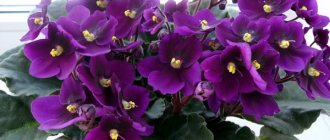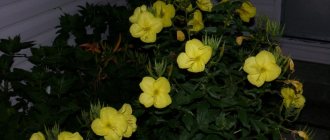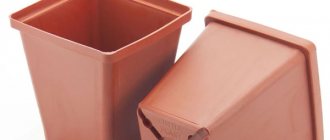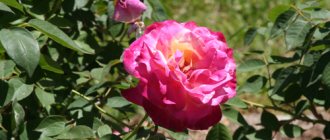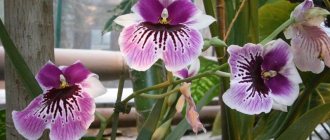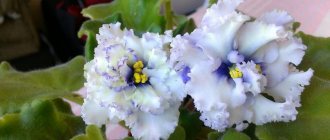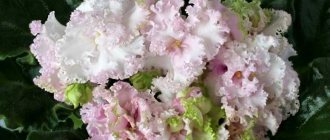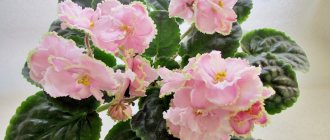Description
First, let's give a description of the Green Rose violet.
Its leaves are large and slightly wavy at the edges. The predominant color is beautiful, rich dark green. Growth proceeds from the center to the edges, resulting in the formation of a strong rosette.
But, of course, the main feature of the variety is its gorgeous flowers. They consist of numerous petals with wavy edges, arranged in the same way as in rose flowers - hence the name. At the edges the petals are pale yellow or even light green. There are also exquisite inclusions – strokes of lilac color. During one flowering, 6-7 flowers are usually formed. Moreover, with a new flowering, the shade and structure of the flowers can differ significantly - this makes the growing process especially interesting. Colors can also be affected by ambient temperature. If the temperature drops below +20 degrees Celsius, then light colors predominate - yellow and light green. But if the room is hot - above +26 degrees - then a large number of purple and even crimson inclusions appear on the petals. Of course, when choosing a sprout, any florist expects that it will retain the characteristics of the parent plant. However, this is not always observed in violets. Quite often, a young plant has flowers of a different color, very different from the flowers of its parents. Such specimens are usually called “sport”. Violet Green Rose is no exception. Therefore, you should be prepared for this.
Violet Natalie description and characteristics
Violetta Natalie: photo
A few years ago we released purple Natalie. However, in reality, calling a viola an alto is not entirely correct. These plants are actually Saintpaulias, but due to their resemblance to another type of plant, this plant is popularly called purple. The Natalie variety is a large-flowered crop, the flowers have a double appearance, the rosette of the plants is always symmetrical and well-formed. The foliage is red inside and dark green in front. Usually, for the first time, double inflorescences are not formed in Natalie’s violets, but after the second and subsequent flowering, duplicity becomes more and more apparent.
Suitable soil and pot
Before you start breeding violets, you need to take care of suitable growing conditions. There are several subtleties here that are very important to know about.
First of all, the pot. It would seem that everything is simple here - any container with drainage holes in the lower part will do, so that excess moisture can be freely removed without leading to rotting of the root system. However, the size of the plant should be taken into account here. It is not worth planting a tiny violet in a large pot. Otherwise, the plant will devote all its efforts to developing the root system. This will take many months and all this time the violet will not bloom - hardly anyone will be happy with this situation. Therefore, it is advisable to plant a small leaf with roots in a small pot. Then the root system will quickly occupy the entire available volume and the plant will finally begin to bloom. Over time, the grown plant will need to be replanted - we’ll talk about this a little later.
The choice of soil also needs to be taken very seriously. It is advisable to use fertile soil - black soil or any other soil mixed with compost - an excellent fertilizer. If the soil is too dense, then it would be a good idea to slightly dilute it with sand to facilitate the passage of moisture and oxygen to the roots.
Of course, it is advisable to pour a little crushed stone or pebbles at the bottom of the pot, and only then pour soil on top of them - then the plant will develop most quickly.
Correct conditions
In order for the violet of the Green Rose variety to actively grow and develop, it is necessary to provide it with certain conditions. First of all, these are humidity, temperature and lighting. Let's look at each of the parameters in more detail.
Like most violets, this variety prefers high air humidity - 50% or more. However, at home, this indicator is quite difficult to maintain - especially in winter, when radiators and heating devices dry out the air. Therefore, it would be a good idea to use a special humidifier or simply spray the plants with a spray bottle once or twice a day.
In general, violets are not too demanding on temperature conditions, successfully developing in a fairly wide range. But still, they grow best at temperatures from +18 to +30 degrees Celsius. As mentioned above, the appearance of flowers depends on this indicator.
Any plant needs a sufficient amount of light so that the process of photosynthesis actively occurs in the leaves. In summer there are usually no problems - there is enough lighting. True, you need to make sure that the violet does not get burned from direct sunlight - it is better to place the pot not on the south side. Otherwise, overheating will cause the leaves and flowers to wither and then dry out. But in winter there is clearly not enough light. Therefore, in order for the plant to develop successfully, it is necessary to provide them with a sufficient amount of artificial lighting. Fortunately, coping with the task is not at all difficult - just install a fluorescent lamp on the window.
Restoration of the variety.
Good day, dear forum users!
Today I want to address the topic of restoring a variety that for some reason has lost its original properties. Collecting violets (and, in general, any ornamental plants) is not only a beautiful, exciting hobby, but also a huge responsibility for preserving varieties for future generations. And for those selling planting material, it also means “company prestige,” so to speak. In addition, many collectors help our wonderful breeders test new varieties by growing new products and seedlings. Selection work does not end with pollination of suitable varieties and growing new plants from the resulting seeds; consolidation of the properties of a variety sometimes lasts up to 5 years, but it does not end there either. If you uncontrollably plant all the leaves in a row in the ground, over time, a gorgeous large-flowered terry variety can degenerate into a smallish simpleton, only vaguely reminiscent of the original variety. This happened with many old varieties. In our city, I observed for several years how the magnificent Makuni variety, Loretta, degraded and changed. The variety is incredibly prolific and ever-blooming with huge double flowers. It’s a pity that I don’t have a single photograph, because my relationship with this variety didn’t work out for a long time, and there was simply nothing to photograph plants at the market from friends 13 years ago. On the Internet I found only one photo of this variety, but it had already lost its properties: https://violet-life.forum2x2.ru/t675-topic Loretta. Our collectors' plants looked much more luxuriant. For several years, in my own collection, I observed the degradation of the St. Valentine variety, when instead of lush double flowers, such as on this first purchased rosette of this variety:
Plants with simple flowers began to fade:
To return the variety to its original appearance, it took about 2 years to select leaves from under the fullest flowers for planting,
before rosettes with double and semi-double flowers appeared again.
Selection of planting material is not a trifle. To preserve the properties of the variety, it is best to plant leaves from under the most regular peduncles - with the most pronounced features of the variety, the largest and double flowers, the largest number of buds. Such leaves carry maximum information about the variety and practically do not produce sports in the offspring. In my own collection, I practice only this method of planting cuttings in order to obtain children for myself and for sale. To do this, it is not at all necessary to damage the rosette during flowering; it is enough to simply mark the desired leaf with a sticker and remove it when the peduncle fades:
I make sure to indicate the letter “m” on the sticker so that when seating the children, I can leave one for myself to update the variety, or to improve it. If you buy a leaf at an exhibition, it is not at all necessary to demand such a leaf from collectors exhibiting their plants; rarely, who will do this, especially on the first day of the exhibition. The fact is that almost all the plants presented there are specially prepared for exhibitions; at the first stage of preparation, all peduncles and lower leaves are removed, so most of the leaves of the displayed rosettes are already from under the peduncles and will produce the correct offspring. And towards the end of the exhibition, most rosettes have only forelocks left, so if you buy a leaf from any plant, you will get good offspring. All of the above has been tested by many years of practice.
Now I want to finally move on to where this whole story began. About 11 years ago I got a wonderful variety called Makuni – Banker:
For about 2 years it behaved superbly, until something strange happened: the leaves of the young rosettes began to curl, grew ugly, no treatments or transplants helped. The rosette of this variety is compact and cannot boast of a large number of leaves, and then there’s this problem. Often, the rosettes, which were straight in infancy, began to curl the leaves by the time the peduncles began to form.
It is almost impossible to find this variety now, since its character is complex, and in the summer the flowers can also become very small. If winter flowers reach 8-9 cm,
then summer ones are no more than 5, and even the white border disappears, since the variety loves coolness and natural daylight.
To preserve the variety, year after year I planted the straightest leaves from under the largest peduncles for renewal. This, either a struggle or a war, took me about 7 years; the first freaks appeared in 2010. Here are a few plants taken in different years: 2012
2015:
2016:
Of course, one could abandon all this, write it off as an irreparable genetic deformity and look for a replacement variety, but the deformity of the leaves did not affect the flowering, all the rosettes bloomed all year round with huge flowers almost continuously, only in the summer the flowers became slightly smaller. Besides, it’s not so easy to find a blue color like this with a white edging and a compact rosette, so I continued to struggle. I tried to find information on this problem, turned to more experienced comrades, but I didn’t find anything definite except this material:
https://www.vehi.net/brokgauz/all/100/100321.shtml, in order not to re-read everything, here is a quote regarding my problem: “Heteromorphism refers to various changes in the shape of a plant, sometimes disfiguring it beyond recognition. This includes cases of strong growth of individual parts of the leaf, flower and other organs, the appearance of leaf-like outgrowths on parts of the flower, twisting of the stems, the formation of fruits with constrictions, curvature of leaves and fruits; in Pteris quadriaurita, some leaves sometimes take on a completely unusual shape, becoming extremely narrow and strongly dissected. This is the so-called leaf dimorphism. Albinism, i.e. the phenomenon of loss of pigment in leaves and other green organs of plants, also causes the formation of deformities. The white areas of albino leaves do not absorb air carbon well, and therefore develop weaker than the green areas of the same leaves, which is why variegated plants in cases of albinism have smaller leaves than the leaves of the same normal plants. At the same time, the leaf sometimes loses its symmetry; one half of the plate is larger than the other, as can be seen in Prunus Laurocerasus fol. var., in Rhamnus Alaternus fv, Evonymus japonica fv and other plants. In cherry laurel, the albino half of the blade sometimes completely dries out and falls off, as a result of which the main nerve of the leaf is located, as it were, at its edge, and the normal half of the blade is bent in a hook-like manner. The sheet changes beyond recognition. The surface of albino leaves is often distorted and distorted. The phenomena of degeneration or involution (degeneration) are also sometimes expressed by the formation of ugly forms. Many degenerate plants become dwarfs."
And only last year I finally had babies with straight and even leaves, this was not the only rosette, as in previous years, so there was no end to the joy:
I have repeatedly stated that violets are plants for the patient; they know how to reward patience and care. Now the second correct rosette has begun to throw out flower stalks, so the wonderful legacy of Makuni will live on and delight more than one generation of violet lovers. Now my beauty looks like this:
I hope my experience will be useful, the main thing is not to lose optimism.
Germination and planting
Now let's talk about the propagation of Green Rose violets. Flowers are quite easy to germinate. If you see a beautiful plant from your friends, you can simply ask them to separate a single leaf from it. Of course, it is advisable to choose an even, beautiful and large leaf, and not from the edge, but directly from the center - they receive the most nutrients, which is why they are the most viable. After that, half the work is already done!
All that remains is to place the leaf in a small container of water. Make sure that the lower end (cut) is always in water and never dries out - this will lead to the death of the plant. But at the same time, only the cutting itself should come into contact with water, and not the leaf - otherwise excess moisture will have a bad effect on it, and even rot may appear.
After a few days, small roots will appear at the bottom of the leaf. So it’s time to plant the plant in the ground. What soil and pot to choose is described above. All that remains is to moisten the soil well, dig a small hole in it, place a leaf there so that all the roots are in the hole, and carefully cover it with soil on top, lightly compacting it for density. That's all! Now the plant will probably actively grow and develop.
A little about watering
Violets should be watered as the soil dries. Accordingly, this will have to be done more often in the summer, and less often in the winter. In addition, the soil dries out faster in small pots than in large ones.
Watering should be done only with settled water - not cold from the tap. It is advisable to pour water into a suitable container - a glass, jar or any other with a wide neck (to facilitate the process of chlorine evaporation) and leave for a day. During this time, it will warm up to room temperature and get rid of dangerous chlorine. Too hot or cold water may well lead to diseases and damage to the roots.
When watering, try to pour water directly onto the ground. If it gets on the leaves on a hot sunny day, burns are possible - white spots will appear on their surface.
Transplantation
It was already mentioned above that violets need to be replanted regularly. Up to one year it can easily grow in a small pot. But then you should transplant it into a larger pot and repeat the procedure every two years.
Old plants especially cause a lot of trouble. It is not enough to simply replant them - you need to carefully remove the outer leaves directly from the rhizome, leaving only the middle. This rejuvenation of plants leads to active growth.
With young violets everything is much simpler. You need to prepare a pot into which you plan to transplant the plant, pour soil into it and make a large depression in it. The soil in the pot with the violet needs to be slightly moistened, and then carefully turned over, trying to shake it out along with the plant - here it is very important not to damage the root system, otherwise the violet will hurt and may even die. All that remains is to place the soil in the prepared hole and water it well.
Don't forget about fertilizers
For the first six months after planting in fresh soil, there is no need to fertilize the violet - the soil contains all the necessary substances. Then you need to feed the flower every two weeks - this is especially important during the flowering period.
An actively growing plant needs to be fertilized with nitrogen fertilizers - they ensure rapid growth of green mass (stems, leaves). Immediately after transplanting, you can add a little phosphorus, which is needed for the rapid development of the root system. But before flowering, you need to fertilize the violet with potassium fertilizers - then there will be more buds and their size will also increase.
Of course, when fertilizing, carefully study the instructions so as not to harm the plant due to excess microelements.
Violet Emergency (K. Stork)
Emergency blooms with simple or double flowers . The flower is a blood-red pansy with a bright white border along the edge of the petal.
Saturation and brightness do not disappear even during the summer heat , which adds to the attractiveness of this variety.
Photo of Violet Emergence.
Despite the fact that the Emergency violet does not form a bouquet , it is in demand among collectors. Unlike many other varieties, Emergency blooms for a very long time, does not fade over time , and also maintains a white border regardless of the circumstances.
Each peduncle forms at least five buds . They are long and drooping. This is the only significant drawback of this variety. The flowering is long and lush, but collecting all the flowers in one heap is very difficult.
There is no variegation or imprints. The sheets are smooth, with a rich red underside.
When growing this variety, problems may arise with the formation of a rosette. She may resemble a spider.
The cuttings are very long and the leaves are crooked. This is a sign of going into sports. Such children are rejected at an early age.
Also, one of the signs of a genetic mutation is an excessive number of double flowers and the absence of simple pansies.
Possible difficulties during cultivation
Most often, violet lovers encounter aphids and mites. The appearance of aphids can be noticed by the gradually curling leaves. The problem is solved after treating the leaves with a special powder preparation - Mospilan.
Mites most often appear on old, drying leaves. Therefore, if you spend at least a few minutes a couple of times a week removing dry leaves, you will probably not encounter this problem.
Reviews about violet
Marina, Donetsk: “I have had this variety for a very long time. Blooms constantly. Once I forgot to replant it, and it still produced flower stalks. One of the healthiest and most reliable varieties. Even the leaves don’t turn yellow.”
Veronica, St. Petersburg : “There are varieties that do not stand the test of time, or are given into good hands because of their shortcomings. But it was Favorite Child that became my favorite. Emerald foliage, snow-white flowers with blue accents and a lace bouquet are the main advantages of this Saintpaulia.”

